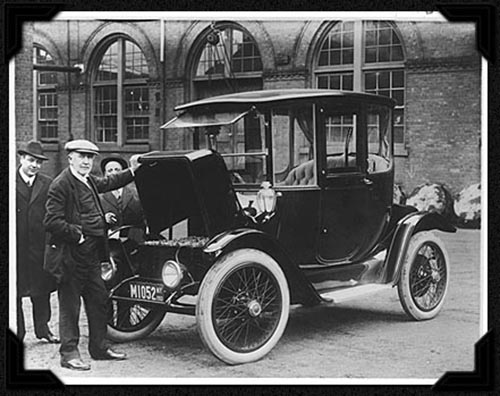I went to my cousin’s wedding this weekend; the reception was at Larz Anderson Auto Museum (and park) up in Boston. During the early stages of the reception, you could actually meander throughout the museum. My dad saw this car and brought it up the next morning to us — essentially, with all the discussions these days about the future of the electric car, we were at a place in the early 1900s — pre-Model T — where electric cars were actually a dominant force on the road. In fact, check out this line from an article about early-1900s New York:
In the early 20th century, electric cars were actually mainstream. In 1900, there were more electric automobiles on New York City streets than cars powered by gasoline. True, there were only 4,192 cars sold in the United States that year, but 1,575 of them were electric. The advantages were obvious — electrics were quiet, clean, and easy to use. Battery power looked like the ideal choice for personal urban transportation (For what it’s worth, both electrics and gas-engined cars were both beaten in sales by steam-powered cars — 1,681 of them, to be precise — but who the hell really thinks steam still makes sense?).
Here’s what happened: William C. Whitney, a former Secretary of the Navy / general tycoon, saw a big business opportunity. He bought a fleet of 13 cabs in New York City and grew the fleet to about 200 fairly quickly. They were electric cars and the idea was pretty simple: at the end of their shifts, drivers returned to a central battery facility on Broadway and swapped out the battery from that day for a new one. This would supposedly deal with the primary problem of electric at the time — that being the distance it can cover on a charge (interestingly, over a century later, that’s still part of the problem). Whitney got greedy, though. After the 200-car fleet did moderately OK, he ordered 1,600 more electric cars. Here’s what happened:
The Electric Vehicle Company didn’t have the money to update the cabs themselves and by the mid 1900s, were several years out-of-date. No longer able to justify the labor and costs of electric operations, the company liquidated its assets, took on new management from one of its subsidiaries, the Columbia Motor Carriage Company, and renewed its fleet with gasoline-powered cabs.
In December, 1889, the Electric Vehicle Company operated 2,000 taxis, trucks, and busses and its factory in Hartford, Connecticut was the largest electric vehicle assembly in the world. By 1901 his regional companies were shut down and in 1907 the Electric Vehicle Company was completely out of business.
The Electric Vehicle Company’s experiment with battery-exchanging taxis was seen as a failure not of a company, but of a system. With the ambitious promises of William Whitney fresh in the public mind, the Electric Vehicle Company’s bankruptcy deeply tarnished the reputation of electric cars. Electric taxi companies all over the world went out of business, unable to foot the maintenance bills for fleets of ever-rarer electric automobiles.
Interesting to consider the implications here. The science wasn’t really there on electric in the 1900s, per se, so gas-based cars may have still come along and been the predominant thing. Had electric worked in some of its early incarnations, though, the U.S. could have focused their infrastructure around charging stations as opposed to gas stations, and states like Texas (and presently North Dakota) might never have become what they did in the business canon. This is all a bit of a long-shot, admittedly, but it’s still interesting to think about. Core lessons here:
1. William C. Whitney is much more important in the American lexicon than you think.
2. Oftentimes, the first 2-3 interactions and contexts that a brand/idea has with the public will essentially define it. That’s why some amazing ideas don’t become big ideas, in a nutshell.
3. Electric is all about the battery. You’re seeing that now too.
